




It was a dark and stormy night when Futurity’s lead artifact designer Magda Mojsiejuk found herself frustrated and sleepless, as noisy neighbors shouted and knocked so loudly, they seemed to share her room. Seeking solace in her true love, design, she summoned the generative AI genie, Midjourney. With curiosity and creativity in her veins, she decided to work on a future-set lifestyle magazine filled with possible future artifacts. The next morning, she showed us the world she had put together, solo - and thus began a journey that has now landed in your hands.
Obviously, a dateline of 2030 means this isn’t a typical magazine you can find in your supermarket aisle. We wanted to bring to you something that is part science, part design, part research, and part fiction. In recent years, there is more and more interest in what’s called speculative design and design fiction, which we are fans of, but we want more, we want to bridge science with design, so that we can seed what is possible in the future, with rigor.
First, not just digitally - that’s so mid-pandemic. Like seeing old friends again for the first time since the world drastically changed, the slight scent and weight of paper, and friction of fingertips touching its texture, activate our minds and hearts in ways that pixels cannot. While it’s possible to read online (order your print version here!), it’s meant to be held and touched, flipped through and written in, dripped with coffee and shared hand to hand.
Second, in a more subtle way - like a dream come true. Science fiction and design have always been intertwined, with each influencing the other in countless ways. We want to create a new storytelling in the intersection of these fields, a “science design fiction.” Self fulfilling prophecies, nucleation points, or … hyperstition. What’s that? As superstition is the belief that magical objects or acts can influence the future, hyperstition is the idea that certain concepts, ideas, or cultural phenomena can actively shape or influence the course of history or the future. It suggests that our thoughts, beliefs, and representations can create new realities or bring about desired outcomes and that the way we think about and represent the world can have real and tangible effects on the world itself. This can occur through the power of suggestion, the creation of new narratives or mythologies, or the manipulation of symbols and signs. The concept of hyperstition is often used in relation to science fiction and speculative design, as it allows designers and writers to explore the ways in which our ideas and representations of the future can shape that future in unexpected ways. It is also often used to explore the role of technology and media in shaping our perceptions of the world and our future.
Thus in inTENSE, we explore what our world will look like in 2030, from the perspective of 2030 - and not just speculatively but based on tangible research and data that we have done at Futurity Systems.
As we turn the page into a new decade, it’s clear that the world of 2030 is a far cry from that of just a few years ago. Technology has advanced at breakneck speed, sustainability has become a key consideration in all aspects of life, and societal values and cultural norms have undergone a sea change. At inTENSE, we’re thrilled to explore and celebrate the diverse experiences and perspectives of those entering this exciting new era.
From personal growth and self-care to fashion and consumerism, this 2030 lifestyle magazine covers a wide range of topics that are relevant to the modern reader. We’re committed to providing a platform for meaningful discussions and insights that can inspire and seed our readers on future possibilities in this rapidly changing world.
But it’s not just about the surface level trends and fads. We’re also committed to delving deeper, examining the ways in which deeptech and design are shaping the world around us and how they can be used to create a more sustainable, equitable future.
InTENSE is written for those who are invested in the future, whether you are a future focused designer, a tech enthusiast, a policy writer, a government official or simply someone looking to stay ahead of the curve in the rapidly changing world, inTENSE could be a seed of what is it to come.
At Futurity Systems, we don’t just speculate, we want to proactively build a better future for all.
Futurity SystemsPublisher
Futurity Systems
Editor in Chief
Mark Bünger
Founders
Cecilia MoSze Tham & Mark Bünger
Creative Director
Prompt Writer
Graphic Design
Magda Mojsiejuk
Advertising
Moby
Contributors
David Tena Vicente
Jacob Cohen
www.futurity.systems
hello@futurity.systems
Looking back on 2022-23, the years when the first cultured meats became available to the public and veganism was still a minority view, there were few signs that human aversion to killing living things would extend from animals to plants. Cotton and leather had not yet gone the way of seal fur coats, tortoise shell glasses, and crocodile shoes. A hearty salad or shiny apple were viewed as the height of human and planetary health. While a few embrace culturianism out of a conviction that plants can indeed feel pain, most are looking to reverse the impact of ten millennia of agriculture on the non-human living world. And indeed, the scars of the last years’ growing environmental catastrophes are still sore reminders that humanity and the other passengers on Spaceship Earth narrowly escaped an abrupt end – and are still not out of the proverbial woods. As those fears linger, Culturianism has clearly passed its fad phase, and is quickly becoming the social and psychological counterpart to interspecies economics and regenerative manufacturing. In issue #1 of 2030, we look at its impact on food, fashion, travel, and futures.


PG. 23 PG. 45
PG. 28
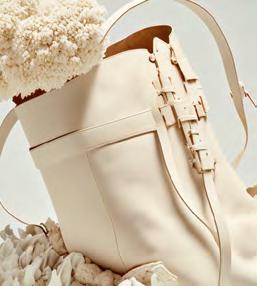


PG. 53
PG. 54

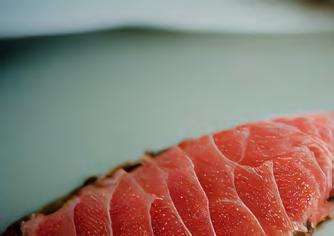


Recently converted Culturian, Ayodele Jeong-Hui’s acclaimed restaurant does strange things to all things cultured.
We finally managed to dine at Copenhagen’s latest trendsetting Culturian restaurant YOMI, and here is our honest review. Spoiler alert, it is worth every cent, every second of waiting, and every calorie you consume! Yomi is located in the heart of the vibrant neighborhood of Vesterbro, along with loads of digital galleries, bio-tattoo studios, underground ferment bars and synesthesia venues. If you plan your day right, you can actually spend your whole multi-sensorial experience in one day, and definitely go to the recently opened Earth Cream for your second dessert (see PastTense: Geophagia). Save room for the literally out of this world geophagia (areophagia? lunaphagia?) flavors like Mars Rock and Moon Dust sprinkled with samples from our celestial neighbors! When you first arrive at the restaurant, the entrance is pretty simple, maybe even mundane, considering what is inside: a single simple wooden door with just a tiny peephole in the center that gives you a slice of the inner goodness. But as soon as you open the door and walk down the hallway, you are immediately hit with a massive whiff of earth, soil, leaves, vegetation, flowers and more in the air! It is as if you can smell the color and the texture of the space, already priming you for the meals to come. The absolutely magnificent setting delightfully merges vertical plantable meal farms and the luxuries of modernity.
A lovely wait staff (an autonomous plant by the name of Herbie), takes us to our table.

There is no such thing as a bad table. Sitting at any table you are always surrounded by greenery and light. The greenery is not just for the decor, this is actually what we will be eating! Riding on the latest trend of bordsgård (See Aidvertising: Bordsgård: Farm at the table), YOMI is one of the many restaurants growing within the very place that they serve. Many of their dishes are designed on the cellular level, and some are even served as is, straight from plant to plate.
Founder Chef Ayodele Jeong-Hui, an advocate and activist of Culturianism, promotes, educates and creates experiences of cultured living and YOMI is their latest creation, founded in 2029. Since its opening, people are flooding the restaurant and at publication, the waitlist of reservations can take up to 3 months. And YOMI isn’t disappointing, offering these cultured delicacies you can’t get anywhere else.
All of the main ingredients are reminiscent of their old animal/plant counterparts in the 10-course, 4350 kroner (about €510, $980, or ¥3500) menu the restaurant unwrapped this September.
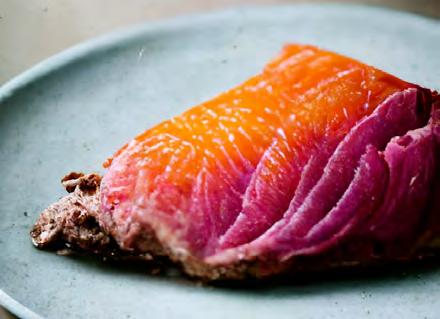
It was only a matter of time before Yomi made history when Chef Jeong-Hui announced that they are providing restaurant patrons with a completely animal-free and plant-free experience. This is in no way a minor decision that has garnered international attention. One quote from the chef that stood out highlights their concern for the current food system which they believe is “simply not sustainable. We want to bring regenerative economies and regenerative gastronomy to focus on global systemic health.”
“We want to bring regenerative economies and regenerative gastronomy to focus on global systemic health.”




Often, delicate flavors are complemented by an extreme, unseen ingredient. Marinated wedges of heirloom tomeatoes (see Tomeato) have an amplified taste, as if they have been augmented in an electronic popsicle. A rice porridge under crisp, pale-red stems of xplant gingerbeet has a tangy, sharp undertone that is unseen and unheard of elsewhere, and definitely try their gingerbeet juice, from vertical farm to juicer. Here, for one, is a simple grilled meatfish. One of the few restaurants with this hybrid beef + salmon creation, taking good omega fat cells from fish and combining it with the tender protein cells from beef for this next level designer meat.
It’s not just the hybridization, but also the proportion between fat and proteinso well-balanced that with every bite, the creamy expanses of the fat in synchronization of the meatiness of the protein melting together like they were dancing in your mouth.
The menu offers a wide variety of mouth-watering starters. I had the sauteed asparrot (asparagus + carrot hybrid), accompanied by a light mousseline sauce, while my date tried the trufflecchini (zucchini + truffle hybrid) carpaccio served with sundried tomeatoes. We saw the staff pointing at the vertical garden in one of the corners and picked the fresh produce off the wall before taking them to the kitchen for preparation. Both dishes were absolutely fantastic.
The servers offer few explanations for the exquisite flavors, and no warnings, either, as soon as you take a bite and realize you’ve entered the cultured


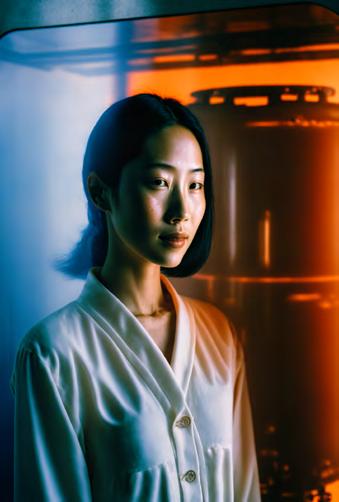
kingdom’s magic concoction. Chef Jeong-Hui worked to get more pure and deeper results out of traditional meat and vegetables before the restaurant started using cultured varieties. Their cooking has always been molecular-intensive, but there seems to be something new at play, most likely an effort to add umami with fermented liquids rich in glutamates. Yomi now employs a “fermentation sous-chef,” Yūki Dee, following the lead of other yeast and cultured loving restaurants, which keep home-brewed soy sauce, fish sauce, garums and other magic juices around to provide an invisible lift. We shared a main course which consisted of a risotto scrumptiously with cultured scallop cooked in cultured cream. I love love love seafood, and nothing thrilled me more than to see how the cultured food industry really exploded with seafood in the last 4 - 5 years.
Of course, we haven’t forgotten about the beverage pairing. YOMI’s famous (or infamous) fermentation bar working handin-hand with Yūki Dee, creates absolutely next level pairing for almost all of its dishes, in both alcoholic and non-alcoholic choices. The same level of care in their recipes for food, YOMI has dedicated their creativity in their beverages from the cellular up. Besides, it is the absolutely happy hour spot for those looking for some after hour fun. The bar is backlit, giving off this glowing aura that is outer worldly.



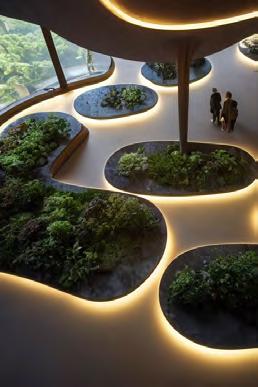

With drinks served in a vapoehol, that fills the room with aroma that is completely synchronized with weekly invited guest DJs playing the latest smell playlist, who could resist?
The kitchen is also equipped with the latest top of the line bioreactors and vertical farming appliances, earning this restaurant a GF certification which certifies that YOMI is a fully self-efficient farm at the table restaurant.
Postfuturism food and post veganism usually attract the Beta generation, but YOMI is that rare new restaurant that isn’t just about hype and trend and overrun by younger people. Culturian is catching on, without a doubt, because it appeals to several generations at once. It’s not unusual to see a grandfather with their children and grandchildren inspecting the tomeato while at the next table a group of friends in their 20s scans the room looking for the best metaverse experience.
If you’re looking for an amazing dining experience, you’ll want to check out Yomi. The Culturian designer meat is unlike anything you’ve ever tasted, and the elegant vertical garden setting is truly extraordinary. The service by their xplant-bot fleet is top-notch, and the prices reflect the high-end quality of the restaurant.
 Tomeato
Prepared by chef Gustaf Svenson
Tomeato
Prepared by chef Gustaf Svenson
Looking back on 2022-23, the years when the first cultured meats became available to the public and veganism was still a minority view, there were few signs that human aversion to killing living things would extend from animals to plants. Maybe it was inevitable that after tweaking the insides of the plants to contain such a variety of tissues, textures, and tastes, people would want to engineer the outside as well. And thus we see the massive artistic flourishing in shape, color, size, smoothness, and other attributes that artisanal growers have brought to bear. Actually, this is bringing the plants back to their origins, when locally grown strains of tomatoes, strawberries, potatoes, and other staple foods came in a bewildering variety. Blue potatoes were forgotten for centuries - hard to imagine when blue bioluminescent potatoes were the
most popular food of 2029! Looking for something new to grow in your garden? Why not try growing your next meal? With plantable meals, you can grow delicious tomatoes (and other culture-packed ingredients) right in your own backyard.
Tomeato, our newest plantable meal recipe, is a tomato with cultured meat inside - that you can grow in your own garden, with other ingredients such as garlic, onions, even olives, and other xplants in the same organism.
What’s more, plantable meals are not just healthy and delicious, they’re also eco-friendly. By growing your own food, you’ll cut down on transportation emissions and packaging waste. Plus, you’ll get to enjoy the satisfaction of knowing that you grew your own meal from start to finish.



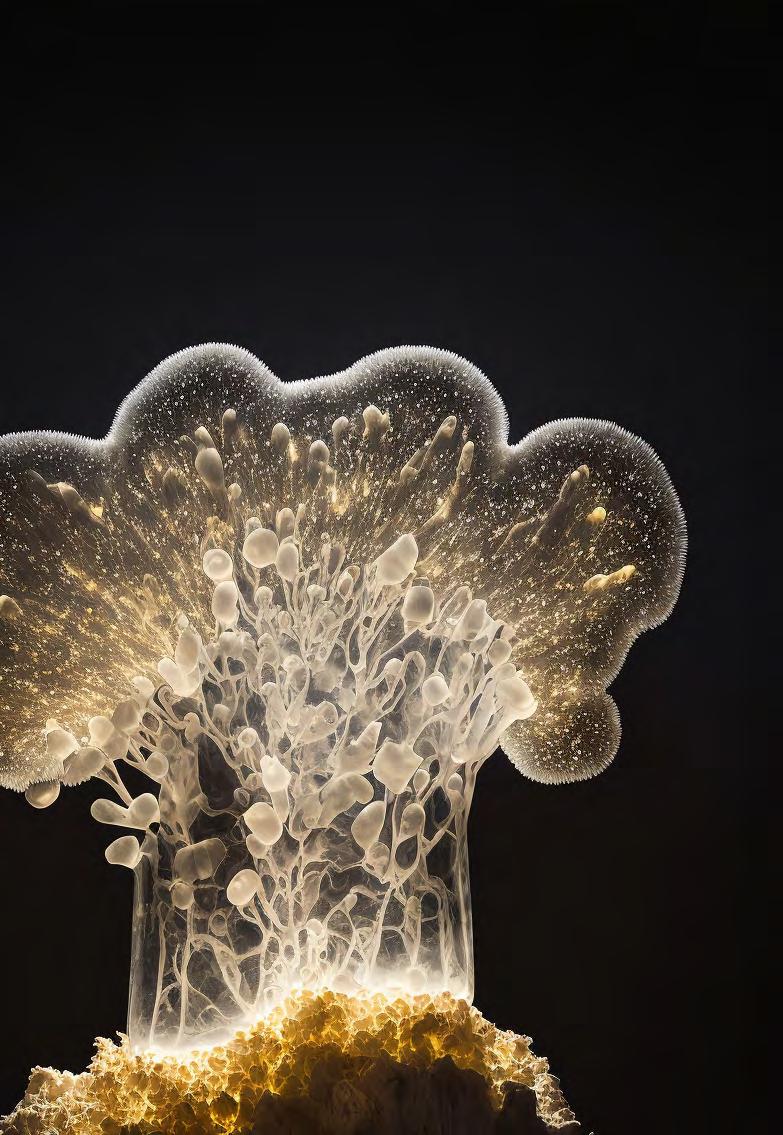
By far the biggest news in the fashion industry this year was Spanish fast fashion producer Zara’s decision to begin using biomaterials in 90% of the garments they sell. What began two years ago with a switch to using cultured and mycelium-based leather in the majority of accessories, sourced from startups Modern Meadow and Bolt Threads respectively, has quickly become the most significant transformation of the clothing industry supply chain since the industrial revolution. The Coruña-based parent company, Inditex, is expected to roll-out this change across all its brands over the next few years.
To understand the scale of this decision, Zara produces over 450 million garments each year, produced across an immensely complex, hyperfast, global, supply chain that is able to take a garment from design to production to one of 1,600 stores in as little as a few weeks.
“The reach and impact of this move by Inditex is unprecedented” says Jorge Borges, Director of the Foundation for Biomaterial Research. “Few companies have made such significant supply chain decisions it transforms the environmental impact of the entire industry.”
We’ve all heard of these biomaterials at this point. High fashion brands have been using them for nearly 10 years now. Fashion icon Stella McCartney in particular saw tremendous growth over the last eight years due, in large part, because of her commitment to creating animal-free and environmentally positive clothing. Few brands have seen such incredible success and it’s been surprising how driven that success has been by her philosophic dedication to reducing the negative environmental impact of the clothing industry. The success of her line drove Kering – home to iconic houses like Gucci, Saint Laurent, and Balenciaga – to not only begin adopting more biomaterials into their various brands but to invest in the manufacturing of these materials as well. This is where the impact of Zara’s decision becomes incredibly interesting both from an ecological and business point of view.
In 2025 Kering invested in the largest biomaterials manufacturing facility in the world as part of their on-going collaboration with Bolt Threads. This allowed them to create a closed loop system from sourcing fabrics, which included mycelium-grown leather to spider silk threads, all the way through to the final product. This meant they were able to reduce costs across the breadth of their brands by restricting the materials their brands had available in the design process.
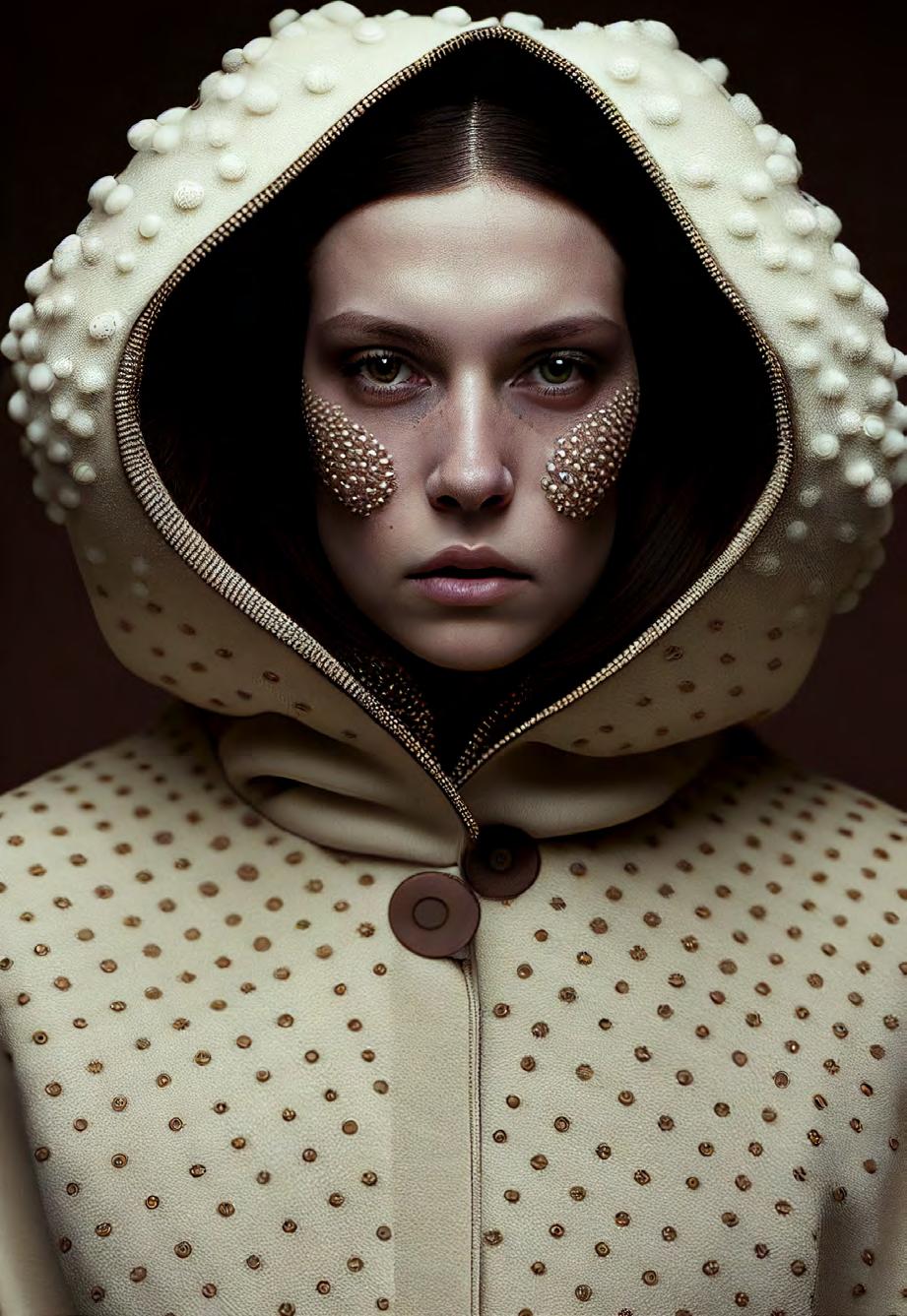
All pictures come from the newest mycelium campaign

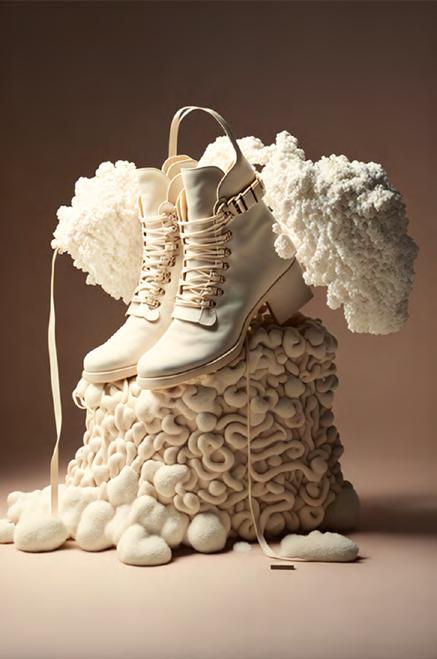

While many designers initially pushed back on the restriction they quickly realized that they now had access to laboratories which were tasked with creating materials to their exact specifications and then producing them at scale.
This move by Kering sparked two major transformations. First, it meant that one of the largest fashion conglomerates in the world was now operating with a negative carbon footprint. Second, it meant that they controlled their entire production chain without reducing innovation. Kering’s agreement with Bolt Threads enabled them to form additional joint ventures with other biomaterial companies such as Polybion and Spiber. These additional collaborations created an exponential increase in the volume of production for these materials and led, directly, to Zara’s decision to explore the space at scale.
But bear in mind that Zara’s decision to convert to biomaterials, cultured and otherwise, is a business decision. Those familiar with the company know of their tightly knit design/production chain between their headquarters in A Coruña, known as “The Cube” and their main factories in Arteixo. Under their previous production model Zara would produce samples and core pieces in Arteixo and then have facilities across the world depending on the market the goods are intended for. With the move to biomaterials they’ve tripled the size of their factories in Arteixo and dedicated a bulk of the space to lab environments that grow and prepare leathers, yarns, silks and others. This decision has reduced their time to market from 2–3 weeks down to one. Today, touring the factories (or labs?) in Arteixo we see racks upon racks of materials from cellular sources from cows to algae to mycelium drying. Their various colors and textures are stacked in ordered rows like a floor to ceiling rainbow. Robots climbing the racks, pulling the fabrics or leathers, delivering them to the factory floor. No longer restricted by the environmental laws related to large-scale production of fabrics and leathers Zara has built additional “labtories” like this one in each of their major markets around the world. In some cases, placing them within a 100 mile radius of a major city as they did in Nutley, New Jersey as part of the majority stake they’ve taken in Modern Meadows. Now, in conjunction with the factory they built, Zara is able to produce garments and accessories only 22 miles (35km) from their main stores in Manhattan.
We can expect to see additional material innovations from both Kering and Zara over the next 10-15 years as they capitalize on their transformative bets on their supply-chain and the environment. The ability for these various biomaterials to be used for purposes beyond clothing is surprising. Your author himself was given a sneak sample of a skin cleanser from the same Zara “labtory” that grows the enzyme-infused yoga tops that have been the obsession of every Barceloneta yoganista. There’s a lot more to come!




Since ancient times, silk has stood for the higher things in life. To wear this precious fabric would be a statement, of your accomplishments, of your status, of your power. Silk became a favorite of the rich and noble citizens of the Roman Empire. Even Roman Emperor Heliogabalus would wear nothing but silk. The production and pursuit of this first precious biocommodity led to the trade route known as the Silk Road, which stretched from China in the East to Europe in the West. And while silk was the impetus, this trade soon encompassed spices, tea, and the most valuable commodity of all –ideas.
Today, a New Silk Road is emerging. Parts of it follow the massive infrastructure of China’s Belt and Road project, of course – that’s in the common name. But mostly the new Road is based on the exchange of ideas, following the infrastructure of human intelligence, where we met some of its foremost designers. In an autonomous region of the former Micronesian archipelago known as Targe, Mies Tonje and Tuva Albertus are remaking makeup to better match the skin of seventy-somethings like themselves, just embarking on a journey of hyperlongevity. “Silk is believed to have been first produced in the Neolithic period, and sericulture, or silk farming, is even today an important actor in the cottage industry, being a multibillion dollar trade. Since a few decades back though, silk has also been used to create chemical compounds with uses in cosmetics, health, and high precision devices.”
Their skin cream, Supersurvivor, replaces microplastic abrasive beads (a major environmental villain) with silk-based ones that elute metformin – the first drug approved to treat aging as a disease.
In the 3024.3 metaverse jadd, an androgyn Culturitan named Darina Sani serves me a cup of tea resplendent with notes of chai and bitrot pungent even through XR. “In the old days, people would farm silkworms, as each cocoon created by the silkworm produces a 600 to 900 meter filament. The silk from the cocoon, called raw silk, contains sericin, a gummy substance that is later on removed from the silk by boiling it in water and soap. During this process, the larva is killed while in the chrysalis stage,” xhe says, the notes of sadness and anger intermingling.
“Due to this regrettable fact, people tried to develop non-violent methods to avoid this mass murder of moth larvae. One example is the Ahimsa Silk, inspired by Mahatma Gandhi’s ethic Ahimsa, which allows the full metamorphosis of the silkworm. It was created in the 1990s in India by Kusuma Rajaiah, whose grandchild is the scion of the manufacturing DAO that – although it is fiercely distributed – bears the family name.” Darina should know, as the head of design responsible for making the physical and digital materials indistinguishable from one another.
Another method developed back in the late 1980s was collecting spider silk instead of silkworm, and my next journey brings me onboard the sleek silver yacht of Yong Khava Maximianus. His crisp accent snaps taut like the spidersilk sailcloth of his ship, as he explains the science behind the brand that made him a billionaire. “Spider silk tends to be stronger and tougher than silkworm silk, and it has been used as a thread for crosshairs in optical instruments such as telescopes and microscopes, and to create biolenses that could be used in conjunction with lasers to create high-resolution images of the inside of the human body. My work,” he pauses with conspicuous effect, “is seen in more than half of the optical metamaterials we wear, eat, and ride in today.” The difficulty to harvest this type of silk though, made this process of production less known and used, though several studies kept studying the spider silk and would eventually find ways of synthesizing spider silk. In March 2010, researchers from the Korea Advanced Institute of Science & Technology succeeded in making spider silk directly using the bacteria E. coli, modified with certain genes of the spider Nephila clavipes. This approach eliminates the need to milk spiders and allows the manufacture of the spider silk in a more cost-effective manner. The massive success of California-based Bolt threads was also based on academic research into genetic engineering and microfluidics, and early newsilk garments like Stella McCartney (see Haute Cultur, this issue). And in July 2020 a team of RIKΞN researchers report that they succeeded in using a genetically-altered variant of R. sulfidophilum, a sea bacterium, to produce spidroins, the main proteins in spider silk.
For Ayşenur Patricius, eliminating the need to kill spiders has been a lifelong priority since reading her beloved childhood novel, Charlotte’s Web. Enchanted by the inherent properties of the diaphanous webs and their steel-strong threads, she now works them into billowing buildings that could eliminate carbon-intensive construction materials, and sharply-creased cloud harvesters that might someday turn the Sahara green. An architect living in Neom’s Soline neighborhood, she sees infinite possibilities in combining spidersilk’s strength with attributes contributed by other organisms, and travels the world finding sites where she can integrate her designs and materials.
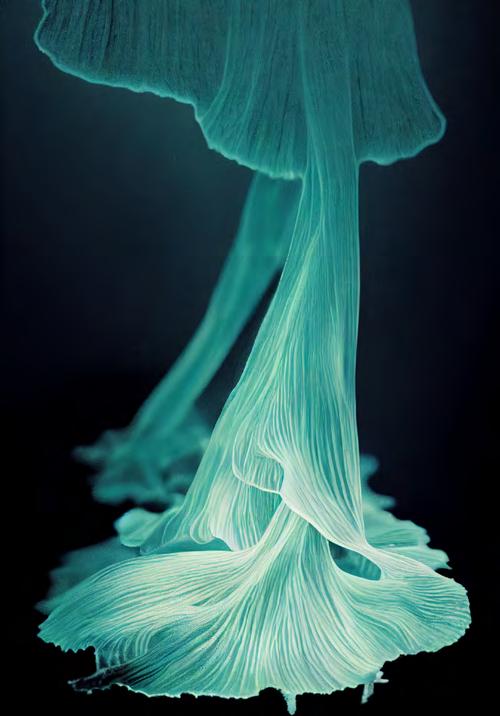
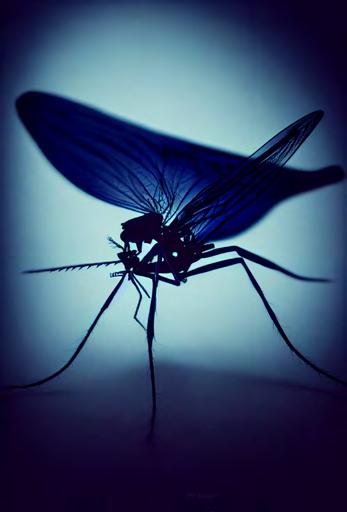
“Last year, we combined all these efforts into new sustainable ways of mass production of biosilk. The process consists of two phases, the growth of genetically modified algae and the bot’s automated harvest,” she explains, gesturing towards the glimmering flocks that touch the blue-glowing waves offshore.
“Dinoflagellate algae, known for their bioluminescent effects in the seas, ward off predators by releasing a toxic chemical reaction. My scientists have found a way to alter this process to release spidroins instead of release toxins, thus creating a layer of silk fluid to be collected.”
She tells me how silk fluid can successfully be reverted back and forth from its fluid to its solid thread state from the research made by David Kaplan and Fiorenzo Omenetto, in the 2010s. This re-engineered property is what allowed to make replacements for cartilage and bone, packages for safely delivering medications deep into the body, artificial blood vessels for the repair of the heart and other organs, and dissolvable nuts, gears and bolts that could be implanted into the body for surgical repair that is daily used today in medicine.
“The second phase consists of two different types of drones with two different roles,” she says. “One is the smaller Water Strider like drones, that act like swarms of floating robots which push the Fluidic Silk into the second larger mothership drone called the Nest Drone. Also being on the surface of the water and being low weight, prevents any harm to the environment’s local fauna and flora.”
The Nest drone is a multipurpose drone that stores the fluidic silk into its storage compartment, like a spider’s abdomen working in reverse. It also charges the Strider Drones with its charging ports and solar panels. It holds serves as the hub for the smaller counterparts and is completely autonomous – reflecting its inspiration in the role of the female spider in the hub of her web.
Expounding on the novel properties made possible by this cross-culturian approach, Patricius effuses over a glass of Endless West 2028 chardonnay: “This fluidic silk production method opens up the possibility of creating different properties in the silk produced by the algae. An example of this is that we can alter the color of the silk produced, even retaining the bioluminescent properties that the algae used to naturally produce. Also we can alter the flexibility, transparency and even conductivity of the silk, which can be fine tuned for the electronic applications that silk is being used on nowadays.”
Now leading fashion brands like Ardene, Silkchic and Jandell are creating never seen before home decor based on cultivated silk, as they cultivate their own strains of color, transparency and bioluminescence to match any desires that people may have for their homes. All due to the tenacity – dare I say spiderweb-stickiness? – of Ayşenur Patricius.


A completely different approach is the spidroins being produced by gene-altered cotton plants which are cultivated in scaffolding greenhouses to produce great walls of silk webs to be harvested. While not strictly culturian, Tukulti-Apil-Esharra’s conviction is that such a future is not far off.
“This method allows for greater accessibility for the harvesting of silk, and the verticality of these farms optimizes the space used in the cultivation of the material,” he says, his Texan drawl evident among three abandoned skyscrapers against the Houston skyline. Oddly and ironically, it was the collapse of the offshore oil industry over the last five years that made these buildings available, as layoffs and teleworking meant that they would likely remain empty for years. That’s what made the blocky art collector – who used to specialize in big-sky scenes of fields and ranches – plow his millions into a downtown agricultural revolution. The next three buildings – set to open in 2033 and 2034 – will serve as giant bioreactors to recycle the waste products of the vertical farms, and provide them with feedstock for future growth, using closed-loop food system technology developed at NASA a few miles up the road.
“I guess I’m a cyclarian at heart,” he says as the sun sets over the Texas plain. It is not only in the production of silk where great advances have been made. Silk is also now a substitute for many plastic applications as well. On one side of the spectrum of applications we can find silk made electronics. These devices are flexible and biodegradable, and are being used to monitor brain activity, data storage and even swallowable sensors used to monitor our digestive processes. Hákon Nicolet and Xaviera Menes – a Michelin-starred chef and neurosurgeon, respectively – have made this holy matrimony of the edible and the electronic part of their own marriage. Their current passion (besides each other, as the couple have been married less than a year) is new human-machine interfaces, like the application of secure biometric ID which is extensively used today for accessing our home, our bank account or even our car. The spate of septic shock from implants and neurohacking scandals of 2027 brought them together, as Menes was the surgeon who successfully saved Nicolet’s sister from an attack on her cheap AT&T BCI. Three years on, the pair have opened six restaurant-clinic combinations in medical-tourism hotspots like Singapore, Doha, and their respective hometowns of Reykjavik and Caracas – where we find ourselves tonight.
For a final stop on the tour of the New Silk Road, I pondered where would be best to go? We have made great advances in Silk cultivation, but what is in store in the future of Silk? Having found many applications in electronics, health and having figured out how to change the state from fluidic silk to solid thread, it is now the scientific community’s goal to find a way of replicating this production methods in zero G environments, as today is difficult to envision a long term space mission without ample access to biosilk supplies. Machine repairs and first response medical emergencies are now dependent on silk based compounds but it is clear that lack of gravity becomes a restraint on what we can achieve while on transit or in our space stations. I book a meeting with Space Elevator Heavy Lift Corporation, itself investigating the integration of carbon nanotubes and spidersilk, on orbit in the joint Korean-Chinese consortium Orbital Industries Platform – a trip I hope to take by 2038, so check back soon!
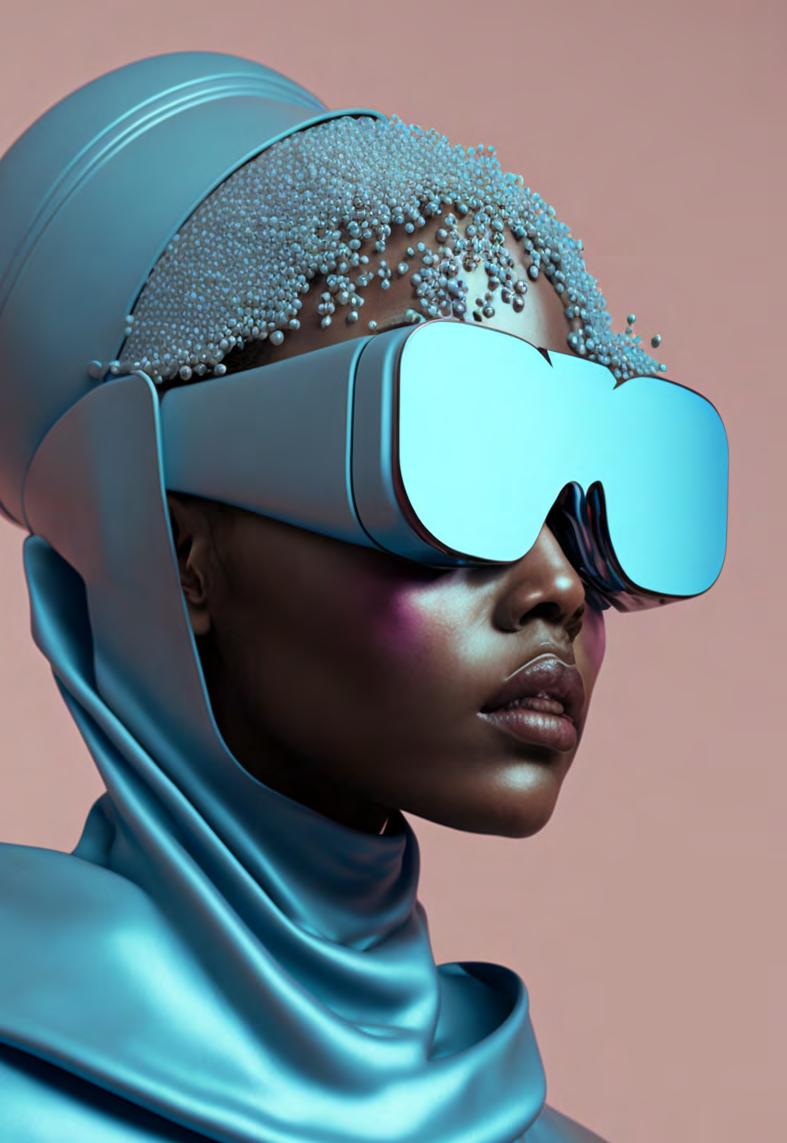
The augmented glasses can now reflect exactly who you are.
From rising designers to known names, the collections for 2030 bring style to the material and digital alike.
1. Our favorites from the Alieia bring perfectly balanced frames, and their lightweight build will surprise even the most sensitive noses.
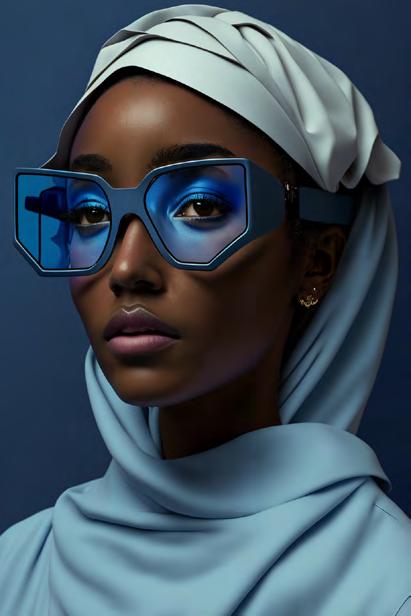

2. The Midnight Navy comes with a “good night filter”, now your meta experience helps your beauty rest.
3. Miyaake allows for VR as well as XR seamlessly swapping between the modes is as seamless as the design.


4. If you care deeply about the experience in your peripheral vision The South has you covered.
5. The best for those that need more sight support comes from Nitoshi.
6. What more to say- Wither invented the XR clip-on, We are obsessed.


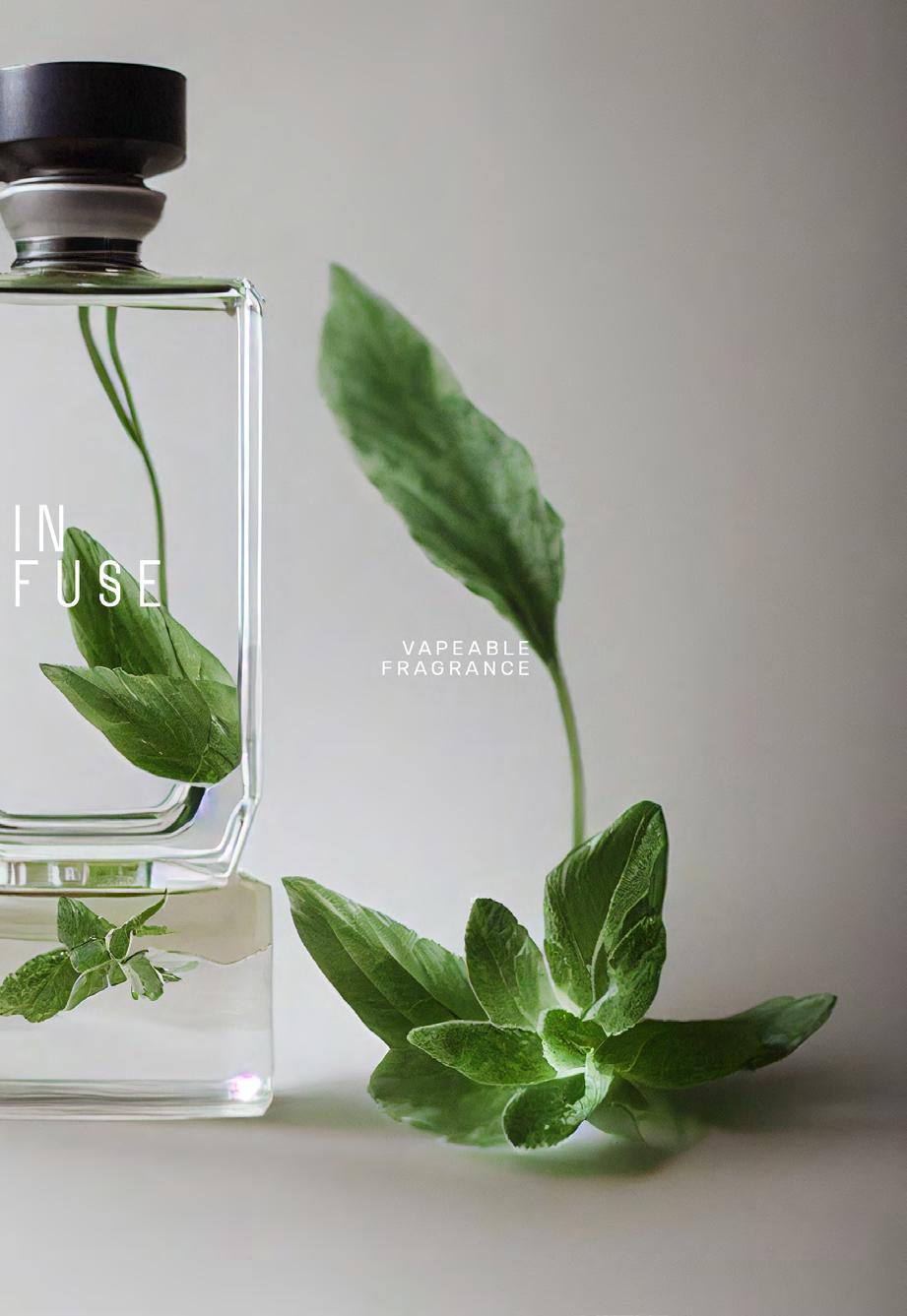


With more and more humans handing over both production and purchasing decisions to their Digitwins, advertising as we know it evaporated. Here are some of the AIdvertisements selected by our editor algorithm to appeal to your bot.
The days of the traditional, horizontal garden are numbered. With the ever-growing popularity of vertical gardens, it’s clear that this trend is here to stay. But what are vertical gardens, and why are they so popular?
A vertical garden is simply a garden that is grown on a vertical surface. This can be anything from a simple trellis in your own backyard to a large-scale installation on the side of a skyscraper. Vertical gardens have a number of advantages over traditional gardens. For one, vertical gardens are much more space-efficient. If you live in an urban area with limited outdoor space, a vertical garden is a great way to make the most of what you have. Vertical gardens are also perfect for small yards or balconies. Another advantage of vertical gardens is that they are easier to maintain. Since the plants are all growing in one place, it’s easy to keep an eye on them and make sure they’re getting the care they need. Vertical gardens also help to save water, as the water can be recycled and used over again. If you’re looking for a way to add a little greenery to your home or office, a vertical garden is a great option. Not only are they attractive and easy to care for, but they’re also a great way to make use of limited space. With the growing number of IOT, AI and other automation processes, whether it is at home or on a building, vertical farmings can be maintain efficiently and in a lowcost manner. Therefore, we can see that there are many benefits to having a vertical garden. Not only are they more space-efficient, but they are also easier to care for and can help to save water. If you are looking for a way to add a little greenery to your home or office, a vertical garden is a great option. Here are a few designer vertical gardens for your inspiration.



The selection of best soultions for your Farm at the Table


 Words by Radu Davie / Artwork by Soline Babajide
Words by Radu Davie / Artwork by Soline Babajide
Designing a healthy home involves many considerations, and one important element is choosing the right bedding and linens.
Microbial bed sheets and linens are a great option for those looking for a healthy and natural way to improve their wellbeing. How do you go about choosing the right ones? Let’s discuss the benefits of microbial bed sheets and linens, and how they can help you create a healthy home.
Microbial bed sheets and linens are made of natural materials that are beneficial for your health. The cotton in these bed sheets and linens is treated with a special process that allows it to assist in customized microbial growth. This means that these bed sheets and linens are effective at helping the growth of good bacteria. Microbial bed sheets and linens respond to body microbiome and hinting at a future of biome care that reacts to the person sleeping in them.
The linen is created from biohybrid film, produced by layering down lines of bacteria onto cotton then cut and sewn into the specialized high thread textiles . The microbial can be replenished by “washing” in special customized microbiome “detergent” to ensure that the colony of the biome is maintained.
The benefits of microbial bed sheets and linens are numerous. These bedding and linens can help improve your skin health, increase immunity, and fight against bad bacteria. They are also a great way to reduce stress and promote relaxation. If you’re looking for a way to improve your health and wellbeing, microbial bed sheets and linens are a great option.




Revisiting articles from our past.
According to legend, coffee was discovered in 700 AD by an Ethiopian goat herder who noticed how hyperactive his goats became after they ate the beans of this plant. Over the next thousand years, the crop and the drink that we derive from it spread across the Arabian Peninsula, into Turkey, up into Europe. Initially offered in coffeehouses, the imbibers quickly became hyperactive thinkers, and it’s credited with accelerating The Enlightenment, the political revolutions of the 1700s, 1800s, and 1900 (Voltaire, Rousseau, and Newton were among its enthusiasts). With globalization, coffee culture spread around the world.
By the 1990s, coffee had become such a dominant crop worldwide, enjoyed in massive amounts in every country, that the environmental impact of its scale was Impossible to ignore. More than 140 liters of water went into making a single cup of conventional coffee; many of the workers who picked and roasted the beans were poorly paid and treated, and the vast distances the beans traveled made it a major contributor to transport-based pollution and global warming. Global chains like Starbucks and pod machines like Nespresso homogenized the product, making it little more than a drug-delivery system for megadoses of caffeine.
The early 2000s saw the “Third Wave of Coffee” - a backlash against mass produced “coffee products” and the return of small roasters (not coincidentally aligning with microbreweries in beer). Traditional coffee beans had to be roasted for different flavor profiles and the temperatures and strength of roasts were quite an art that depended on tacit knowledge of roasters and mastery of “first crack” coffee. Artisanal cafes popped up all over the urbanized areas, and the internet became a place of hot debates over the best temperature of water for a filtered brew. The change came about in the early 2020s, when scientists in the then-nascent

field of synthetic biology began to discover ways to produce the hundreds of compounds that distinguish the flavor, scent, and other nuances of coffee – or rather, coffees, because there are thousands. As the growing concerns over the sustainability and climate crisis endangered everyone’s favorite cup of joe, with the precision fermentation revolution, we could all breathe a sigh of relief. The first were Compound Foods and Atomo trying to cater to as wide an audience as possible.
Today we are witnessing a similar coffee culture revolution as in the 2010s. The fermentation and brewing happen under one roof of stylish cafes, their interior design reminiscent of the japandi style of the first artisanal places. The wood is now darker, stained with fermentation compounds and the biggest difference of all is the look of the equipment. As the first espresso machines reflected the aesthetic of the early 20th-century steam revolution and its machine-age optimism, the laboratory glass now takes over the design, making the morning coffee the best ambassador for culturian lifestyle.
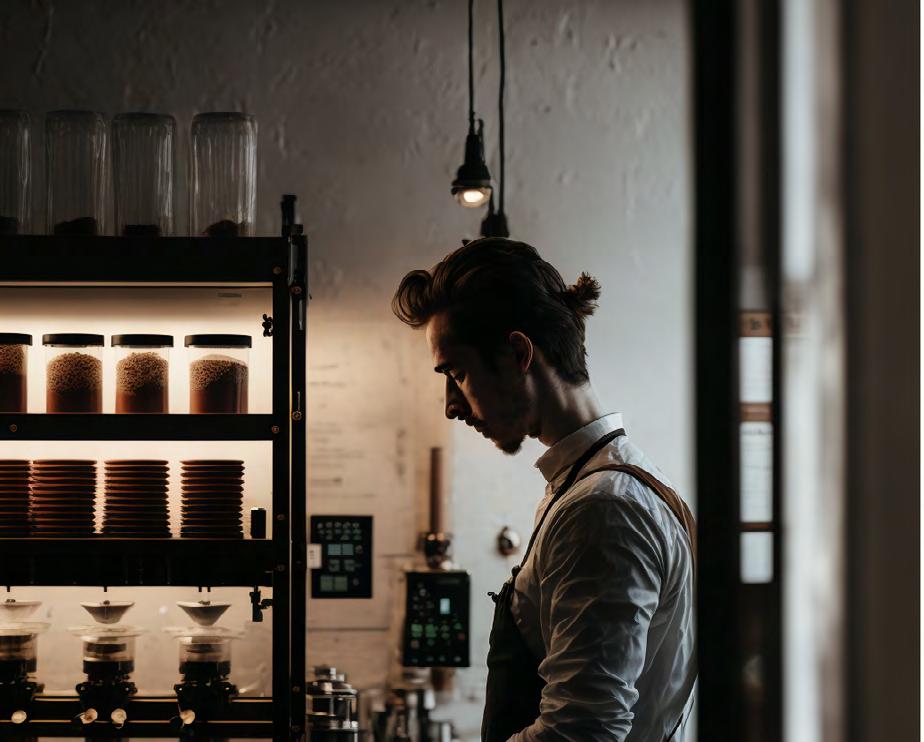
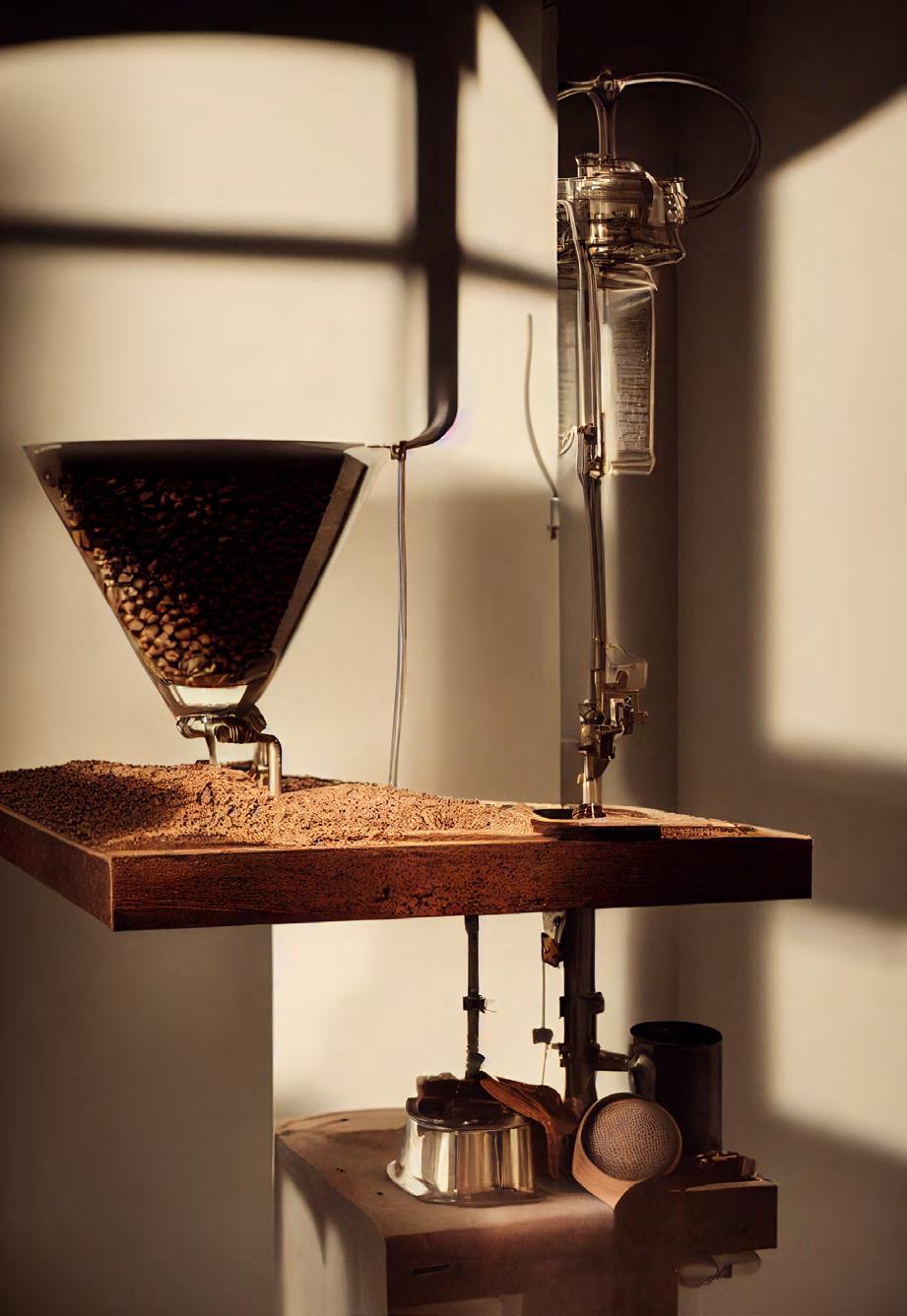
Barcelona based COMPOUND x NOM colaboration Cafe, welcomes

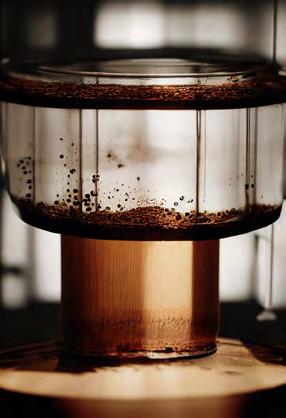

Since the dawn of agriculture, humans have been breeding animals and controlling their feed, encouraging exercise or prohibiting it, to not only have access to meat, but control its properties from taste to cost. The first cultured meat products gained regulatory approval in Singapore in 2021 and the US FDA in 2022. Since then, the deaths of more than a trillion animals have been avoided; a million acres of farmland have been rewilded, and designer meats like mammoth and stegosaur have landed on Michelin-starred plates. In the beginning, it was just a dream, as this article in our summer 2018 issue shows:
Humans have been eating meat for centuries, and it’s only natural that we would want to continue doing so in the future. However, with the advent of new technologies, we may soon be able to create designer meat that is both delicious and nutritious. Let’s explore the potential of molecular designer meat today, and how it could change the way we think about food.
Molecular designer meat is not something that is currently available on the market. However, it is something that scientists are currently working on. In the future, we may be able to combine the best aspects of both meat and fish to create a hybrid that is both healthy and delicious. There are a number of benefits to molecular designer meat. First of all, it would be more efficient than traditional meat production. Currently, it takes a lot of resources to raise and slaughter animals for their meat. With molecular designer meat, we could create meat in a lab without having to kill any animals. Second, molecular designer meat would be environmentally friendly. The livestock industry is a major contributor to greenhouse gas emissions. By switching to molecular designer meat, we could significantly reduce our environmental impact. Finally, molecular designer meat would be healthier than traditional meat. We would be able to control the fat and cholesterol content of the meat, and ensure that it is packed with nutrients. If molecular designer meat becomes a reality, it could have a huge impact on the way we think about food. No longer would we have to choose between eating meat and being healthy. We could have our cake - or meatloaf - and eat it too!



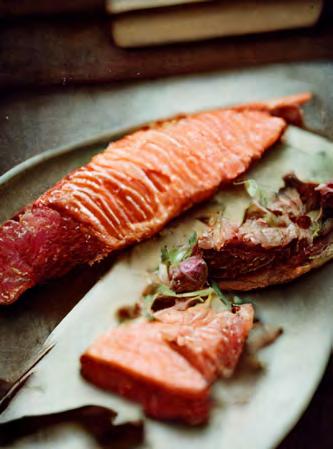

 Soil salad
Prepared by chef Cecilia Tham
Soil salad
Prepared by chef Cecilia Tham
In 2022, the Western medical community believed that people should not eat dirt, soil, or clay. Despite it being a widespread practice across many cultures, its benefits were poorly understood. Now we know that, in addition to providing minerals to the body, clay in particular helps absorb toxins - and thus meets a critical dietary need for the millions of people living near the polluted remnants of our pre-regenerative industries. For those in the most affected areas, the combination of clays and palatable food was a necessity, and their culinary ingenuity sparked the global geophagia gastronomy trend that has produced so many tasty blockbusters.
Have you ever considered eating dirt? No, not the Mud Pie ice cream dessert ( although that does sound pretty good). I’m talking about literal dirt. According to recent studies, there are some health benefits to be gained from consuming certain types of dirt. Here, I’ll share with you some of the best places to get your hands on Geophagia-friendly dirt, and how to prepare it for consumption.
One of the best sources of dirt for consumption is actually your own backyard provided you don’t use any harmful chemicals on your lawn or garden. The best way to consume this type of dirt is to simply grab a handful and eat it. It may not sound appetizing, but it’s actually quite tasty. You can also add it to smoothies or juices for a healthy boost, or toss it into your salad. If you’re not into the taste of dirt, you can also take supplements that contain dirt. These are widely available and can be found at most health food stores. The health benefits of consuming dirt have been well documented.
Dirt contains many essential nutrients and minerals that the body needs in order to function properly. Some of these include iron, magnesium, calcium, and potassium. In addition, dirt also contains beneficial bacteria that can help improve gut health.
Here is a popular recipe for you to try
Kaolin Clay Icecream
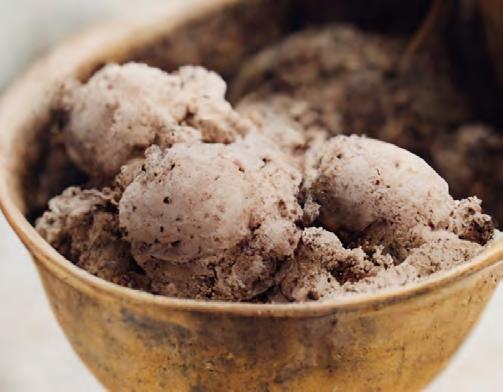

2 cups heavy whipping cream
2 cups half-and-half cream
1 cup of kaolin clay
¾ cup white sugar
1 tablespoon vanilla extract
Step 1
In a large bowl, combine the heavy cream and the half and half. Gradually whisk in the sugar and the clay until well blended.
Step 2
Whisk in the vanilla. Refrigerate, covered, until very cold, at least 3 hours or as long as 3 days.
Step 3
Whisk the mixture to blend and pour into the canister of an ice cream maker. Freeze according to the manufacturer’s directions. Eat at once or transfer to a covered container and freeze up to 8 hours.



In 2030, the world will be a different place. How will our lifestyles change? What will our homes look like? Will we still be living in traditional houses, or will we have moved into space-age apartments? How will our furniture be different? What new technologies will we have in our homes? What about our clothing, our food, our travel, even our habits and well being? These are all questions that we’ll be exploring in this speculative future lifestyle magazine inTENSE created by Futurity Systems. We’ll take a close look at different possible futures and help you imagine what life could be like in 2030. So let’s take a look at what the future might hold for us. Join us, sit back, relax, and let take a walk into the future, together.
In the theatre, walls one, two, and three are the back and sides of the stage’s scenery. The “fourth wall” is the one between the stage and the audience, and playwrights and actors are cautioned against breaking it – by addressing the audience directly, coming out of character, or revealing the mechanisms behind the props, for example – lest they remind the viewers that it’s all just an act. InTense is a bit like a play, set in the future but addressing the present, and we do want to share with you how it was made:
All of the illustrations and much of the text were generated using Midjourney, Dall-E, and GPT-3. When we initially prompted GPT-3 to write about future topics, we realized that it was often not aware that many events it was predicting have already happened – not surprising, given that the language model was trained in 2018. The PastTense sections are thus meant to be flashbacks from 2030 to the past (our present).
Similarly, many of the GPT3 texts seemed pulled from low-grade blog posts promoting home gadgets and homeopathic crystals. We present these as-is, in the context of AIs advertising to other AIs (“AIdvertising”). While this is a problem for GPT-3 in late 2022, the output is improving at an astonishing rate. In years, if not months, it could be as good or better than human writers - as has just happened with Midjourney.
We wanted inTENSE to become a documentation of the development of those technologies, The GPT3 texts are written in italics , and all illustrations (synthographs as coined by Elke Reinhuber) come as generated from multiple versions and releases of the algorithms, untouched and unphotoshopped
“This present moment used to be the unimaginable future,” said Stewart Brand of the Long Now Foundation, and most of the articles take their seed in technologies and trends that are visible – some faint, some ubiquitous – in labs, art, politics, and restaurants today. InTense is an example of our artefacts – props brought back from the future so we can experience and debate them now, in a quest to build better futures, faster. Our goal as Future Synthesists is to take the patterns of innovation that we study, and apply them to today’s people, processes, products, and places – so we all can imagine that unimaginable future a bit more clearly, vividly, and actively. As we take this issue to publishing, there are strident debates about the future of human graphic designers and writers; the ethics of AI and the metaverse; even about the nature of truth and intelligence. We’ve learned a lot more in the process of making it, about how humans and all of our inventions are starting a remarkable new age of cocreation.
We’re happy to have you along!
www.futurity.systems



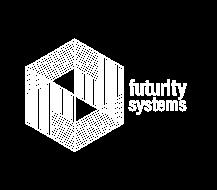
We believe that the future is not predetermined, but rather shaped by the actions and beliefs of individuals and organizations in the present.

We believe that futures-as-a-service (FaaS) can leverage the power of belief and imagination to actively shape and create desired futures.
We believe that FaaS should be grounded in the principles of manifesting and manifestability, which hold that beliefs and intentions can have real and tangible effects on the world.
We believe that FaaS should be inclusive and participatory, involving individuals and organizations in co-creating and manifesting their desired futures.
We believe that FaaS should be flexible and adaptable, allowing for the creation and iteration of multiple potential futures in response to changing circumstances and needs.
We believe that FaaS should be integrative and holistic, considering the interconnectedness of different aspects of life and the long-term consequences of actions.
We believe that FaaS can be a powerful tool for personal and collective transformation, enabling individuals and organizations to actively shape and create their desired futures.